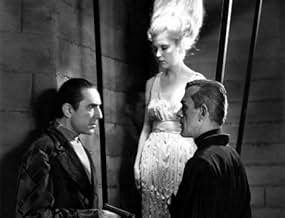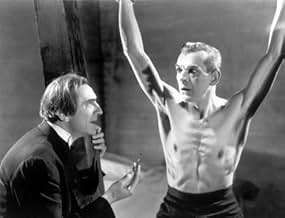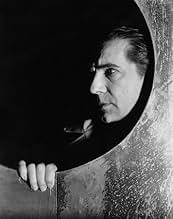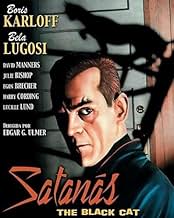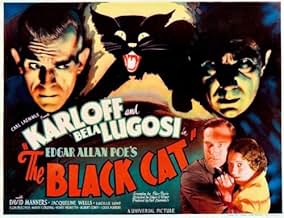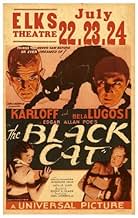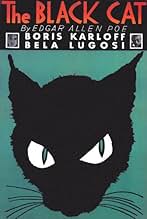IMDb रेटिंग
6.9/10
14 हज़ार
आपकी रेटिंग
अपनी भाषा में प्लॉट जोड़ेंAmerican honeymooners in Hungary become trapped in the home of a Satan-worshipping priest when the bride is taken there for medical help following a road accident.American honeymooners in Hungary become trapped in the home of a Satan-worshipping priest when the bride is taken there for medical help following a road accident.American honeymooners in Hungary become trapped in the home of a Satan-worshipping priest when the bride is taken there for medical help following a road accident.
- पुरस्कार
- 2 जीत और कुल 1 नामांकन
Boris Karloff
- Hjalmar Poelzig
- (as Karloff)
Julie Bishop
- Joan Alison
- (as Jacqueline Wells)
Virginia Ainsworth
- Cultist
- (बिना क्रेडिट के)
Luis Alberni
- Train Steward
- (बिना क्रेडिट के)
King Baggot
- Cultist
- (बिना क्रेडिट के)
Herman Bing
- Car Steward
- (बिना क्रेडिट के)
Symona Boniface
- Cultist
- (बिना क्रेडिट के)
John Carradine
- Cult Organist
- (बिना क्रेडिट के)
André Cheron
- Train Conductor
- (बिना क्रेडिट के)
George Davis
- Bus driver
- (बिना क्रेडिट के)
Andy Devine
- Bit Part
- (बिना क्रेडिट के)
फ़ीचर्ड समीक्षाएं
Made in 1934 by the then 30 year old Director Edgar Ulmer and with the stunning set design by Charles D. Hall the film paired Boris Karloff and Bela Lugosi for the first time together on the screen. This was to cement the two icons together in a screen partnership that would last for several years.
Set in the modern house of Hjalmar Poelzig (no creepy old castle's here) whose home is one of the most stunning modern houses of our time this is a dark story about Devil worship. Poelzig has a room set aside for his evil black masses and has a penchant for the ladies, but only when they are being put to the devil's business. Into this walks a young couple who due to circumstances out of their control end up having to stay the night at his home. They arrive with Dr.Verdegast (Lugosi) who is returning after a absence of many years to settle some unfinished business with his old friend. This is the set up for an explosive encounter between the two into which the young honeymooning couple are thrown.
Truly a masterpiece it should be viewed over and over again.
Watch out for the finale Black Mass in which Karloff spout's authentic sounding incantation's to raise the Devil, he says Latin phrases "Cave Canium" (Beware of the Dog), "In Vito Veritas" (In Wine there if truth) and Cum Grano Salis (with a grain of salt). I could'nt put it better myself.
Set in the modern house of Hjalmar Poelzig (no creepy old castle's here) whose home is one of the most stunning modern houses of our time this is a dark story about Devil worship. Poelzig has a room set aside for his evil black masses and has a penchant for the ladies, but only when they are being put to the devil's business. Into this walks a young couple who due to circumstances out of their control end up having to stay the night at his home. They arrive with Dr.Verdegast (Lugosi) who is returning after a absence of many years to settle some unfinished business with his old friend. This is the set up for an explosive encounter between the two into which the young honeymooning couple are thrown.
Truly a masterpiece it should be viewed over and over again.
Watch out for the finale Black Mass in which Karloff spout's authentic sounding incantation's to raise the Devil, he says Latin phrases "Cave Canium" (Beware of the Dog), "In Vito Veritas" (In Wine there if truth) and Cum Grano Salis (with a grain of salt). I could'nt put it better myself.
Travelling across Eastern Europe, Peter and Joan Allison meet Dr Werdegast on the train. When the bus taking them to their destination crashes, the Allisons go with Werdegast and stay with him at the foreboding castle of Hjalmar Poelzig. However the Allisons find themselves in danger when it becomes apparent that Werdegast and Poelzig have a deadly history with each other.
Although it carries the title of his book and a credit for him on the titles, this film has little to do with Poe's work. In fact, in terms of plotting, it owes very little to anybody because, aside from the actual set up, the plot just goes all to hell very quickly. The set up is interesting and I wanted to know more about the history between these two men, then there is the thing about the black cat and Werdegast, not to mention the fact that Poelzig seems to be very interested in reading about satanic cults! However, none of this is really fully explained - this is partly due to the short run time and so much material, but it must also be blamed on the film not having a strong focus other than atmosphere.
The film still works well as the plot crumbles, but it is a little unsatisfying as it leaves so many half stories and unanswered questions. What it does do well though is atmosphere, the direction is cheap but effective and the lighting works wonders in a cheap set! The cast also contribute to this focus on atmosphere (or style) over plot (or substance). Karloff overdoes things, but he overdoes them very well! There is no real need for him to be as ominous as he is at the start but it is what we have come to expect from him. Lugosi may have tarnished his reputation towards the end of his career, but he is good here. It's hard not to laugh when seeing him convulsed with fear over the cat but he plays it well for the most part. Manners and Wells are both OK but are very much the onscreen representation of the audience and simply have to act shocked by everything and run away lots!
Overall this is a good film but only because of the atmosphere and the influence of two legendary stars in the cast. The plot had potential but not enough time is allowed for it to be explored and the focus is more on the atmosphere than the construction.
Although it carries the title of his book and a credit for him on the titles, this film has little to do with Poe's work. In fact, in terms of plotting, it owes very little to anybody because, aside from the actual set up, the plot just goes all to hell very quickly. The set up is interesting and I wanted to know more about the history between these two men, then there is the thing about the black cat and Werdegast, not to mention the fact that Poelzig seems to be very interested in reading about satanic cults! However, none of this is really fully explained - this is partly due to the short run time and so much material, but it must also be blamed on the film not having a strong focus other than atmosphere.
The film still works well as the plot crumbles, but it is a little unsatisfying as it leaves so many half stories and unanswered questions. What it does do well though is atmosphere, the direction is cheap but effective and the lighting works wonders in a cheap set! The cast also contribute to this focus on atmosphere (or style) over plot (or substance). Karloff overdoes things, but he overdoes them very well! There is no real need for him to be as ominous as he is at the start but it is what we have come to expect from him. Lugosi may have tarnished his reputation towards the end of his career, but he is good here. It's hard not to laugh when seeing him convulsed with fear over the cat but he plays it well for the most part. Manners and Wells are both OK but are very much the onscreen representation of the audience and simply have to act shocked by everything and run away lots!
Overall this is a good film but only because of the atmosphere and the influence of two legendary stars in the cast. The plot had potential but not enough time is allowed for it to be explored and the focus is more on the atmosphere than the construction.
THE BLACK CAT (1934) Starring Boris Karloff, Bela Lugosi, David Manners, Julie Bishop Directed by Edgar Ulmer
The first film to feature both Boris Karloff and Bela Lugosi, THE BLACK CAT was, and remains, innovative and strange. The opening credits claim the film was "suggested by" the Edgar Alan Poe story, but other than the title there is absolutely no connection.
Lugosi gets to play a good guy for a change and he handles it very well. In fact, I might venture to say that the role of Dr. Vitus Werdegast is Lugosi's finest performance, perhaps because it is so much of a departure from the role of Dracula. Karloff plays Hjalmar Poelzig, a Satanic architect with a really freaky hairdo. David Manners and Julie Bishop portray the Allisons, an American couple honeymooning in Hungary (doesn't everyone?).
The real star of this film, though, is the house. What an incredible set! The house, designed and built by Poelzig on the ruins of a WWI fort where thousands of soldiers are entombed, is an architectural marvel, even by today's standards. All glass and steel, the house consists of sharp angles that cast long, expressionistic shadows, which gives the film its extremely creepy atmosphere.
Werdegast (Lugosi) meets the Allisons on a train and later shares a cab with them. As they drive through a storm, he explains that he is going to visit an old friend after having spent 15 years as a prisoner of war. Not far from his friend's house the cab crashes, killing the driver and injuring Mrs. Allison. They carry her to Werdegast's friend's house. The friend, of course, is Poelzig (Karloff) and it soon becomes obvious that the term "friend" is applied very loosely. In fact, the men have become enemies due to the fact that Poelzig betrayed Werdegast during the war, which led to his long imprisonment. In the basement, Poelzig reunites Werdegast with his wife, now dead and whom Poelzig had married himself while Werdegast was in prison. The freaky architect has been keeping her preserved in some sort of suspended animation type thing. When Werdegast demands to know his daughter's whereabouts, Poelzig tells him that she, too, has died.
What follows is a bizarre tale of two men who are opposite sides of the coin. They engage in a chess match (literally and figuratively) with the soul of the injured Mrs. Allison up for grabs. THE BLACK CAT is incredibly creepy and has some real suspenseful moments. It also has some very disturbing scenes, especially for a film made in 1934. The scene of Karloff reciting the black mass in Latin is especially ominous. One cannot, however, help noticing some gaping holes in the plot. Dr. Werdegast is supposed to be Hungary's leading doctors, and yet he has just been released from 15 years of imprisonment. Huh? Also, there is a cruel scene where Lugosi's character kills a black cat (he has a phobia) and nobody seems to think anything about it...even though it appears to have been a pet in the household. These minor points do not take away from the overall viewing experience, though. THE BLACK CAT still looks great after all these years and it still has the ability to make you shudder.
The first film to feature both Boris Karloff and Bela Lugosi, THE BLACK CAT was, and remains, innovative and strange. The opening credits claim the film was "suggested by" the Edgar Alan Poe story, but other than the title there is absolutely no connection.
Lugosi gets to play a good guy for a change and he handles it very well. In fact, I might venture to say that the role of Dr. Vitus Werdegast is Lugosi's finest performance, perhaps because it is so much of a departure from the role of Dracula. Karloff plays Hjalmar Poelzig, a Satanic architect with a really freaky hairdo. David Manners and Julie Bishop portray the Allisons, an American couple honeymooning in Hungary (doesn't everyone?).
The real star of this film, though, is the house. What an incredible set! The house, designed and built by Poelzig on the ruins of a WWI fort where thousands of soldiers are entombed, is an architectural marvel, even by today's standards. All glass and steel, the house consists of sharp angles that cast long, expressionistic shadows, which gives the film its extremely creepy atmosphere.
Werdegast (Lugosi) meets the Allisons on a train and later shares a cab with them. As they drive through a storm, he explains that he is going to visit an old friend after having spent 15 years as a prisoner of war. Not far from his friend's house the cab crashes, killing the driver and injuring Mrs. Allison. They carry her to Werdegast's friend's house. The friend, of course, is Poelzig (Karloff) and it soon becomes obvious that the term "friend" is applied very loosely. In fact, the men have become enemies due to the fact that Poelzig betrayed Werdegast during the war, which led to his long imprisonment. In the basement, Poelzig reunites Werdegast with his wife, now dead and whom Poelzig had married himself while Werdegast was in prison. The freaky architect has been keeping her preserved in some sort of suspended animation type thing. When Werdegast demands to know his daughter's whereabouts, Poelzig tells him that she, too, has died.
What follows is a bizarre tale of two men who are opposite sides of the coin. They engage in a chess match (literally and figuratively) with the soul of the injured Mrs. Allison up for grabs. THE BLACK CAT is incredibly creepy and has some real suspenseful moments. It also has some very disturbing scenes, especially for a film made in 1934. The scene of Karloff reciting the black mass in Latin is especially ominous. One cannot, however, help noticing some gaping holes in the plot. Dr. Werdegast is supposed to be Hungary's leading doctors, and yet he has just been released from 15 years of imprisonment. Huh? Also, there is a cruel scene where Lugosi's character kills a black cat (he has a phobia) and nobody seems to think anything about it...even though it appears to have been a pet in the household. These minor points do not take away from the overall viewing experience, though. THE BLACK CAT still looks great after all these years and it still has the ability to make you shudder.
This early horror film concerns Dr. Vitus (Bela Lugosi) and a couple having an accident . They find shelter into the impressive mansion of architect Poelzig (Boris Karloff) . He built it over the corpses of thousands of dead people in a horrible war whose commander was Poelzig . Karloff followed his success in Frankenstein movie with the title role in this low budget terror classic about the leader of a band of devil-worshippers who wants to steal a gorgeous young woman (Jacqueline Welles : Julie Bishop) from her new husband (David Manners of The mummy).
The movie provides genuine chills , suspense , mystery and is rich and dark , although ludicrous at times . It's an exciting ,bizarre film skillfully paced by Edgar G. Ulmer and results to be one of the most unusual horror film ever made and certainly one of the most unsettling. Suggested by the immortal Edgar Allan Poe novel of the same title which was filmed like as one episode ¨The Black Cat¨ into the ¨Tales of terror¨ by Roger Corman and with Vincent Price and Peter Lorre , however here bears absolutely no resemblance . This gem features sets and production design with standards usually found in movies made by the major studios . The rousing mansion , lounges , rooms get an art nouveau and modernism style , besides the satanic mass is developed in a surrealistic scenario. Art director achieves some remarkable tableaux that could be removed from the movie and hung in art galleries alongside the work of famous painters . A minor classic with outstanding performances from Karloff and Lugosi in their first of many pairing. The picture is today deservedly considered a cult favorite thanks the distinguished teaming.
The movie provides genuine chills , suspense , mystery and is rich and dark , although ludicrous at times . It's an exciting ,bizarre film skillfully paced by Edgar G. Ulmer and results to be one of the most unusual horror film ever made and certainly one of the most unsettling. Suggested by the immortal Edgar Allan Poe novel of the same title which was filmed like as one episode ¨The Black Cat¨ into the ¨Tales of terror¨ by Roger Corman and with Vincent Price and Peter Lorre , however here bears absolutely no resemblance . This gem features sets and production design with standards usually found in movies made by the major studios . The rousing mansion , lounges , rooms get an art nouveau and modernism style , besides the satanic mass is developed in a surrealistic scenario. Art director achieves some remarkable tableaux that could be removed from the movie and hung in art galleries alongside the work of famous painters . A minor classic with outstanding performances from Karloff and Lugosi in their first of many pairing. The picture is today deservedly considered a cult favorite thanks the distinguished teaming.
I won't comment about the acting or plot -- there's plenty of that here already. What I'd rather do is call attention to the visuals -- the cinematography, lighting, costuming, and especially the set design.
Normally, horror films take place in ancient settings -- crude medieval fortresses and rustic castles that are dark, cluttered and gloomy. But this one is set in a perversely utopian sci-fi fantasy -- the clean lined, impeccably detailed, generously glazed modernistic and (usually) radiantly lit white-and-silver upper floor interiors of the house.
The lower floor is an expressionistic prison, also clean lined, but still dungeon-like with its windowless walls of exposed board-formed concrete. An elegant steel spiral staircase connects the two, and the angular expressionism reaches its culmination in the chamber used for the black mass.
Karloff's costumes recall Oskar Schemmer's Bauhaus-produced work -- angular, broad-shouldered, narrow-waisted and elegant. Even the haircut of this man of the future in sharp and angular. His character is an engineer and architect and is given the name -- Poelzig -- of a famous expressionist German architect and film set designer of the time, who was a colleague of the director on an earlier film. The elegant futurism in carried down to the detail level, including a digital night-table clock and an abstract chess set. Much of the genius of this movie is that it breaks the horror-movie visual mold, and floods it with light, creating a fascinating tension between plot and setting.
Normally, horror films take place in ancient settings -- crude medieval fortresses and rustic castles that are dark, cluttered and gloomy. But this one is set in a perversely utopian sci-fi fantasy -- the clean lined, impeccably detailed, generously glazed modernistic and (usually) radiantly lit white-and-silver upper floor interiors of the house.
The lower floor is an expressionistic prison, also clean lined, but still dungeon-like with its windowless walls of exposed board-formed concrete. An elegant steel spiral staircase connects the two, and the angular expressionism reaches its culmination in the chamber used for the black mass.
Karloff's costumes recall Oskar Schemmer's Bauhaus-produced work -- angular, broad-shouldered, narrow-waisted and elegant. Even the haircut of this man of the future in sharp and angular. His character is an engineer and architect and is given the name -- Poelzig -- of a famous expressionist German architect and film set designer of the time, who was a colleague of the director on an earlier film. The elegant futurism in carried down to the detail level, including a digital night-table clock and an abstract chess set. Much of the genius of this movie is that it breaks the horror-movie visual mold, and floods it with light, creating a fascinating tension between plot and setting.
क्या आपको पता है
- ट्रिवियाAmong the unconventional elements of this film was the soundtrack. At a time (early 1930s) when movie music was usually limited to the titles and credits, Edgar G. Ulmer had an almost continuous background score throughout the entire film.
- गूफ़Vitus identifies Kurgaal as being "near Omsk, by Lake Baikal." In reality Omsk and Lake Baikal are approximately 1000 miles apart and are nowhere near each other.
- भाव
Hjalmar Poelzig: Did you hear that, Vitus? The phone is dead. Even the phone is dead.
- कनेक्शनEdited from Rome Express (1932)
टॉप पसंद
रेटिंग देने के लिए साइन-इन करें और वैयक्तिकृत सुझावों के लिए वॉचलिस्ट करें
विवरण
- रिलीज़ की तारीख़
- कंट्री ऑफ़ ओरिजिन
- भाषाएं
- इस रूप में भी जाना जाता है
- El gato negro
- फ़िल्माने की जगहें
- उत्पादन कंपनी
- IMDbPro पर और कंपनी क्रेडिट देखें
बॉक्स ऑफ़िस
- बजट
- $95,745(अनुमानित)
- दुनिया भर में सकल
- $180
- चलने की अवधि1 घंटा 5 मिनट
- रंग
- पक्ष अनुपात
- 1.37 : 1
इस पेज में योगदान दें
किसी बदलाव का सुझाव दें या अनुपलब्ध कॉन्टेंट जोड़ें



